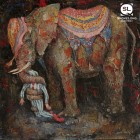I’ll get to the serious questions in a second, but I’m dying to know if you’ve ever spent hours on the telephone trying to get a rebate, or if you’ve ever spent hours in the shower debating postminimalist art.
I don’t know if I have been on the phone trying to get a rebate, but postminimalist art and I get along very well with the shower. In fact, I remember a sculpture piece one of my friends did where she gave 1,000 teabags a bath or something obscene like that. She took photos of the floating Lipton teabags in a typical, footless bathtub (I guess they are cheaper than most other brands?) and I can’t remember what she captioned the photos, but it was something along the lines of how they symbolized the female uterus. I suspect that gives a new twist to the idea of brewing tampons? I mix language and things up all the time. I fumble and I tumble into things awkwardly. If there were such a thing as a linguistic klutz, I would be that.
In an interview with Atticus Lanigan and Giovanna Coppola at Tantra Bensko’s great site Everything Experimental Writing, you say that you often equate death with pleasure. Without giving anything away about “Doing an Eva Hesse on a Man”–or maybe give something away if you want–can you say a bit more about this association?
Death is pleasure. That is why we can only do it once, right? At the end of our life? Save the best for last? One reason why I equate death with pleasure is because death is like the skin that shields the corporeal from the ethereal flesh of existence (life). Death is like night wearing life’s clothing, and if you massage or seduce or provoke that skin enough it can provide a kind of inactive euphoria. A penetration from friction. Pleasure is born from turning the skin of daylight inside out the way a woman (or a man, for that matter) rolls back her eyes during an orgasm so we can see the whiteness of her globular organs and it’s the same whiteness we see on the skin of daylight and it’s the same whiteness we see at a Vietnamese funeral.
The artist Eva Hesse–or rather her piece “Hang up”–serves as a pivot to the startling end of the story. As I understand it, because I have just Googled it of course, the title of Hesse’s piece refers to the hanging of art but also a psychological preoccupation. How did this piece of art influence your story?
Hesse’s “Hang Up” is fairly minimal and white and quite erotic, don’t you think? There were several ways in which I have somewhat skewed the presentation of Hesse’s sculpture: 1) The title of Hesse’s work comes to me quite sonically. I saw the sound of it before I understood the context of it. Separated from the work itself, the title suspends itself in the ether of language. I took that language down and made it live in my story. 2) I was fixated with Hesse’s death (psychological preoccupation?) She died so young! And she was so talented, too! I wanted to turn Eva Hesse into a verb because a verb tends to live longer in language (I have no basis for making such a specious declaration) – but she became something else, a noun! I want to quotidianize her work and to quotidianize her because great dead artists (like Eva Hesse herself) die quickly and then spend their life in a museum. Thus, I took her “hang up” so that one of my protagonists could “hang up” the phone whenever they like (which we do every day) and know that whenever they carry out a quotidian conversation such as asking for a rebate, they would memorize and immortalize her, and at the same time make her a daily consumption of postmodern behavior. Also, when a reader experiences a literary work, the experience exists outside the realm of one or two or three dimensions. When I take her art and convert it from a sculpture to an audible pleasure and then instruct it to travel at a higher textual speed through psychological time, emotional space, and sonic texture, it gets the kind of literary experience that can only exist in a material dream.
What are you working on now?
I am working on a large project requiring stamina. I am studying Leslie Thornton’s digital sheep. Leslie Thornton is a filmmaker and a painter. Her sheep do nothing but move around a digital canvas eating grass, and I have to stay focused on that. The concept is boring, but the actual art of writing it is not.



 The SmokeLong Grand Micro Contest (The Mikey) is now an annual competition celebrating and compensating the best micro fiction and nonfiction online.
The SmokeLong Grand Micro Contest (The Mikey) is now an annual competition celebrating and compensating the best micro fiction and nonfiction online.